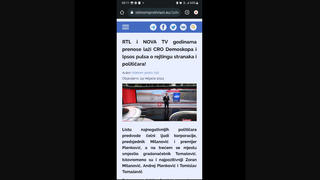
Is 5G radiation classified as a carcinogen and included in the same class of carcinogens as the metal lead? No, that's not true: 5G radiation is not in the same carcinogen group as lead because it was never classified as a carcinogen. The International Agency for Research on Cancer divided carcinogens into four groups, depending on the potential dangers they pose. Lead is classified as a Group 2B carcinogen, while 5G non-ionizing radiation is not included into any of the groups. On the other hand, ionizing radiation is classified as a Group 1 carcinogen.
The claim appeared in a TikTok video (archived here), in English with subtitles in Croatian, published on March 14, 2024. It opened:
Radiation from radio frequency is classified in the same category of carcinogens as lead. One advisor to the World Health Organization said there is enough evidence that if they were to re-evaluate radiofrequency radiation, it would be placed in class one, i.e., a human carcinogen, and governments could not possibly ignore that. Some say the scientific debate about the health effect of microwave radiation is over, but the question remains, can we afford to take this risk? Medical doctors are requesting delayed deployment until testing can be conducted on the long term biological effects of 5G technology.
This is what the post looked like on TikTok at the time of writing:
(Source: TikTok screenshot taken on Tue Mar 19 09:53:06 2024 UTC)
Lead
Lead (archived here) is a chemical element with the symbol Pb. It is a naturally occurring toxic metal found in the Earth's crust. Exposure to lead (archived here) causes long-term harm in adults, including increased risk of high blood pressure, cardiovascular problems, kidney damage, lung, stomach, and bladder cancer (archived here). It is particularly dangerous to young children because it affects the development of the brain and nervous system.
Lead is classified by the International Agency for Research on Cancer (IARC) as a Group 2B carcinogen, meaning that it is possibly carcinogenic to humans (archived here).

(Source: IARC screenshot taken on Tue Mar 19 10:43:57 2024 UTC)
Non-ionizing radiation
5G (archived here) is the fifth generation of mobile networks, a technology that establishes wireless connections between devices and the internet, with a higher speed and capacity than its predecessors, such as 4G or 3G. 5G operates on two frequencies (archived here), the highest of which ranges from 24.25 GHz to 52.6 GHz. It emits non-ionizing radiation (archived here), from things such as cell phones, Wi-Fi routers and other technology regularly used by the public. Non-ionizing radiation is not classified as a carcinogen and has not been shown to cause harm to human health. A search in the IARC carcinogens database with the term "non-ionizing radiation," conducted by Lead Stories on March 19, 2024, found no matching records.
The World Health Organization published a Q&A (archived here) on the topic "Radiation: 5G mobile networks and health." In response to the question "What are the potential health risks of 5G?" it states:
To date, and after much research performed, no adverse health effect has been causally linked with exposure to wireless technologies. Health-related conclusions are drawn from studies performed across the entire radio spectrum but, so far, only a few studies have been carried out at the frequencies to be used by 5G.
Tissue heating is the main mechanism of interaction between radiofrequency fields and the human body. Radiofrequency exposure levels from current technologies result in negligible temperature rise in the human body.
As the frequency increases, there is less penetration into the body tissues and absorption of the energy becomes more confined to the surface of the body (skin and eye). Provided that the overall exposure remains below international guidelines, no consequences for public health are anticipated.
Additionally, research (archived here) published in the Journal of Exposure Science and Environmental Epidemiology found "no confirmed evidence that low-level RF fields above 6GHz such as those used by the 5G network are hazardous to human health."
Ionizing radiation
On the other hand, ionizing radiation (archived here), which is a different form of radiation than non-ionizing radiation, is linked to cancer, since it carries enough energy to break chemical bonds, knock electrons out of atoms, and alter molecules within the cells of the body. Ionizing radiation is classified as a Group 1 carcinogen by the IARC, meaning it is carcinogenic to humans.

(Source: IARC screenshot taken on Tue Mar 19 10:43:57 2024 UTC)









